 |
||
 |
||
![]()
![]()
![]()
![]()
![]()
![]()
![]()
![]()
![]()
![]()
![]()
![]()
![]()
![]()
![]()
![]()
![]()
![]()
![]()
![]()
![]()
![]()
![]()
![]()
![]()
![]()
![]()
![]()
IMPORTANT: No material may be reproduced, copied or redistributed from this site, without the express written consent of doktorjon.co.uk
All the detailed information on this site is provided in good faith; and as such, Doktor Jon does not accept responsibility for any consequential loss, injury or disadvantage resulting from any individual or organisation acting on the details contained herein.
© doktorjon.com 2004 - 2010
Image 1 - In the photo on the right, a camera has been set up to produce a picture roughly equivalent to one using a 6mm wide angle lens (x 0.75 mag.) fitted onto a 1/3" format CCD camera.
Based on a 1.8 metre ( 6 foot ) tall person walking down the centre (red) line towards the camera, the top of their head would roughly follow the path of the upper (blue) line.
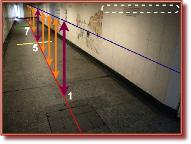
A working example of the 'Cone of Containment'
The idea behind maximising the effectiveness of any CCTV camera, is to try and minimise the lens width of coverage, and align the targets direction of travel, as near to the lens axis (centreline) as possible.
This is what Doktor Jon describes as the "Cone of Containment" ... containing the target within the smallest cone possible.
The following simple example demonstrates how a camera can be set up in different ways, in a pedestrian underpass (subway); whilst the actual camera alignment has not been optimised, it does however show a clear variance in target size, when using different lens options.
![]()
![]()
![]()
![]()
![]()
![]()
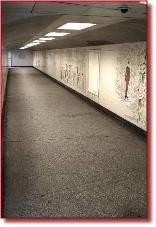
At a distance of approximately nine metres from the camera (shown as Position 5), the person would occupy approx. 25% of the screen height (shown as the vertical purple line), which would not be considered adequate for identification purposes with a conventional CCTV camera.
As the target moves closer to the camera, their relative speed gradually appears to increase, providing far fewer opportunities to capture a decent facial image (in other words there are less images recorded in the recognition zone closest to the camera).
Image 2 - In the picture on the left, the camera has been realigned slightly to produce an image roughly equivalent to that from a 16mm lens (a x2 magnification Telephoto) on a 1/3" format CCD camera.
Again based on a 1.8 metre tall person walking down the centre (red) line, at the same distance of approximately nine metres from the camera (position 5), a person would now occupy roughly 68% of the screen height, which is far more effective for identification purposes.
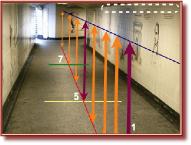
Note also that the blue line ( head track ) is slightly closer to the lens centre axis, which means that the face is not only more effectively presented to camera, but also remains on screen for longer.
As the target moves from position 5 towards position 1, the face will appear much larger on screen, and by using a quality lens of similar price to the one fitted in the image above, there is no overall cost penalty for the system operator, so much better evidential quality images ... for free!
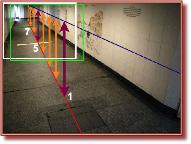
Image 3 (right) - The picture shows the original image 1, and the reframed section (white rectangle) which is actually the area roughly covered in image 2.
In practice, image 2 (above) is actually showing far more of the tunnel wall on the left side of the picture, than is really necessary. If it was reframed (as with the green rectangle), that would be even better. Incidentally, the relative target height in image two when the person is standing at position 1, is actually equivalent to approx 135% of screen height.
Just to also quickly mention, the dotted white box (shown top right in image 2) would really be the ideal place for the time and date caption information, as no part of a target would ever present on screen in this location (i.e. it's way above their heads!!).
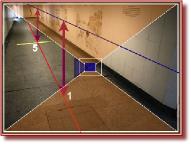
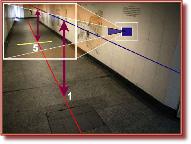
So, what of the "Cone of Containment" concept?
Well in the Wide Angle view (image 4 - left) you can see the approximate angle of the cone as indicated by the mauve triangle .... it's way too wide!
The Telephoto view (image 5 - below), shows a much smaller angle, which is almost always the best way to ensure optimised imaging, particularly under controlled conditions.
The small blue rectangles represent the cameras CCD imager, and are simply drawn for illustrative purposes only - overall the images are not intended to be absolutely accurate, but to simply convey the basic concept.
Keep the cone as narrow as possible, and install the camera in such a way as to keep targets within the cone, for as long as is achievable.
If you have any questions, comments or suggestions that you'd like to raise with Doktor Jon, write to:- info[at]doktorjon.co.uk





